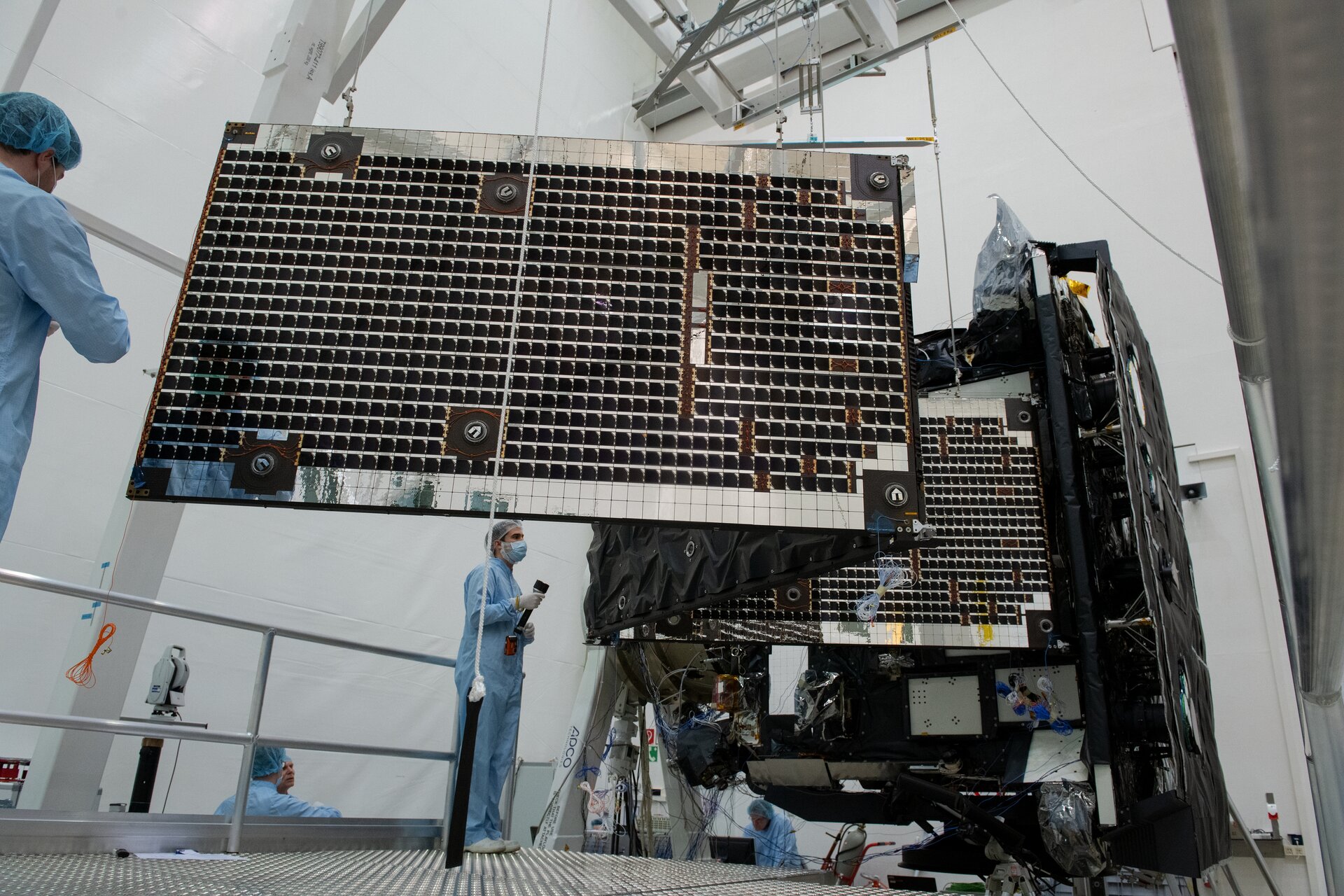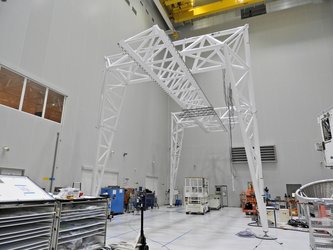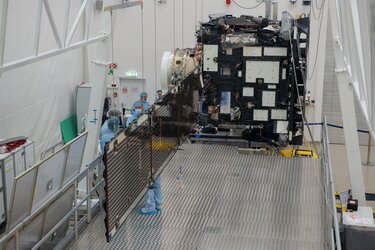Accept all cookies Accept only essential cookies See our Cookie Notice

About ESA
The European Space Agency (ESA) is Europe’s gateway to space. Its mission is to shape the development of Europe’s space capability and ensure that investment in space continues to deliver benefits to the citizens of Europe and the world.
Highlights
ESA - United space in Europe
This is ESA ESA facts Member States & Cooperating States Funding Director General Top management For Member State Delegations European vision European Space Policy ESA & EU Responsibility & Sustainability Annual Report Calendar of meetings Corporate newsEstablishments & sites
ESA Headquarters ESA ESTEC ESA ESOC ESA ESRIN ESA EAC ESA ESAC Europe's Spaceport ESA ESEC ESA ECSAT Brussels Office Washington OfficeWorking with ESA
Business with ESA ESA Commercialisation Gateway Law at ESA Careers Cyber resilience at ESA IT at ESA Newsroom Partnerships Merchandising Licence Education Open Space Innovation Platform Integrity and Reporting Administrative Tribunal Health and SafetyMore about ESA
History ESA Historical Archives Exhibitions Publications Art & Culture ESA Merchandise Kids Diversity ESA Brand Centre ESA ChampionsLatest
Space in Member States
Find out more about space activities in our 22 Member States, and understand how ESA works together with their national agencies, institutions and organisations.
Science & Exploration
Exploring our Solar System and unlocking the secrets of the Universe
Go to topicAstronauts
Missions
Juice Euclid Webb Solar Orbiter BepiColombo Gaia ExoMars Cheops Exoplanet missions More missionsActivities
International Space Station Orion service module Gateway Concordia Caves & Pangaea BenefitsLatest
Space Safety
Protecting life and infrastructure on Earth and in orbit
Go to topicAsteroids
Asteroids and Planetary Defence Asteroid danger explained Flyeye telescope: asteroid detection Hera mission: asteroid deflection Near-Earth Object Coordination CentreSpace junk
About space debris Space debris by the numbers Space Environment Report In space refuelling, refurbishing and removingSafety from space
Clean Space ecodesign Zero Debris Technologies Space for Earth Supporting Sustainable DevelopmentLatest
Applications
Using space to benefit citizens and meet future challenges on Earth
Go to topicObserving the Earth
Observing the Earth Future EO Copernicus Meteorology Space for our climate Satellite missionsCommercialisation
ESA Commercialisation Gateway Open Space Innovation Platform Business Incubation ESA Space SolutionsLatest
Enabling & Support
Making space accessible and developing the technologies for the future
Go to topicBuilding missions
Space Engineering and Technology Test centre Laboratories Concurrent Design Facility Preparing for the future Shaping the Future Discovery and Preparation Advanced Concepts TeamSpace transportation
Space Transportation Ariane Vega Space Rider Future space transportation Boost! Europe's Spaceport Launches from Europe's Spaceport from 2012Latest

Solar Orbiter array deployment test
Thank you for liking
You have already liked this page, you can only like it once!
ESA’s Solar Orbiter mission is being put through its paces to prepare it for facing the Sun following launch in February 2020.
The spacecraft is being tested to withstand the vibrations of launch, the vacuum of space, and the extreme temperature ranges and magnetic environment that it will experience as it journeys from Earth to within the orbit of the innermost planet, Mercury. The deployment mechanisms of instrument booms, antennas and solar arrays are also checked out.
This image captures the scene part way through a solar array deployment test at the IABG facilities in Ottobrunn, Germany, earlier this year. Fully extended, the tip of the array stretches 8.2 m from the spacecraft body. The panels are suspended from above to simulate the weightlessness of space. Click here to watch a video of the full deployment test.
The solar arrays have to provide the required power throughout the mission over a wide range of distances from the Sun. Close to the Sun, the spacecraft will endure around 13 times the amount of solar heating that Earth-orbiting satellites experience, with temperatures in excess of 500ºC, so the solar arrays can also be rotated to avoid overheating when closest to the Sun.
Solar Orbiter's mission is to provide new views of our star, in particular providing the first close-up observations of the Sun’s poles. Its unique orbit will allow scientists to study the Sun and its outer atmosphere, the ‘corona’, in much more detail than previously possible.
We cannot usually see the corona because it is overwhelmed by the bright light of the Sun’s surface itself. During a total eclipse however, when the Moon passes between Earth and the Sun, that light is blocked, revealing the beautiful white glowing corona around the Sun, its structures shaped by the Sun’s magnetic field. This rare sight will be much sought after by astronomers in parts of South America on 2 July, who are getting ready to watch a total solar eclipse.
We essentially live in the extended atmosphere of the Sun. The corona continuously expands and spreads into space, developing as the solar wind that interacts with the planets and beyond, sometimes leading to aurora and other space weather effects observed at Earth.
Solar Orbiter will measure the solar wind and magnetic fields in the vicinity of the spacecraft while simultaneously taking high-resolution images of features on the Sun, linking the two together. This will give us unprecedented insight into how the Sun creates and controls its dynamic atmosphere, and how it interacts with the planets. Studying the Sun-Earth connection is fundamentally important to understanding how our Solar System works in its entirety.
In addition to delivering ground-breaking science in its own right, Solar Orbiter also has important synergies with NASA’s Parker Solar Probe. Coordinated observations will contribute greatly to our understanding of the Sun and its environment.
Solar Orbiter is an ESA-led mission with strong NASA participation. The prime contractor is Airbus Defence and Space. The spacecraft is scheduled for launch from Cape Canaveral in February 2020.
-
CREDIT
ESA – S. Corvaja -
LICENCE
ESA Standard Licence

Solar array deployment rig

Solar Orbiter solar array deployment

Solar Orbiter array deployment

Solar Orbiter array deployment















 Germany
Germany
 Austria
Austria
 Belgium
Belgium
 Denmark
Denmark
 Spain
Spain
 Estonia
Estonia
 Finland
Finland
 France
France
 Greece
Greece
 Hungary
Hungary
 Ireland
Ireland
 Italy
Italy
 Luxembourg
Luxembourg
 Norway
Norway
 The Netherlands
The Netherlands
 Poland
Poland
 Portugal
Portugal
 Czechia
Czechia
 Romania
Romania
 United Kingdom
United Kingdom
 Sweden
Sweden
 Switzerland
Switzerland






















